Why Choose a Belt Sander for Woodworking
Almost every woodworking project requires some sanding wood finishing, whether it is cabinets in the kitchen or shelves in the pantry. But whatever your home improvement project, you will need a sander that offers versatility and functionality to get the job done.
A belt sander meets both these requirements and is a powerful tool able to give your woodworking projects an even finish. Belt sanders are multifunctional tools that let you work with not only wood but metal as well. Here are eight of the best belt sanders for woodworking projects, each with its own distinctive features to give you the most optimal choice for all your DIY projects:
Best Overall Belt Sander For Woodworking:
1. Makita 9403 11 Amp 4-Inch-by-24-Inch
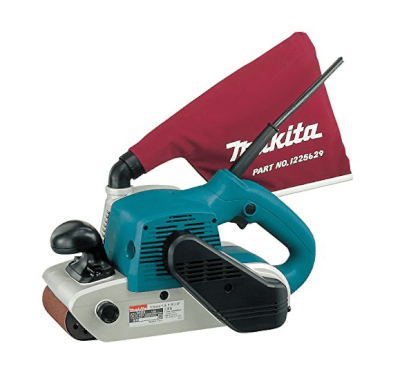 If you need a belt sander that can be used for more extended periods, then Makita has the best belt sander for woodworking for you. This belt sander performs much quieter than the competition and has an ergonomic grip hold meaning for more extended periods; you can hold it without attaining possible hand cramps.
If you need a belt sander that can be used for more extended periods, then Makita has the best belt sander for woodworking for you. This belt sander performs much quieter than the competition and has an ergonomic grip hold meaning for more extended periods; you can hold it without attaining possible hand cramps.
It is a quick performing machine that works at 1640 feet per minute, with an 11 Amp motor to run the mile. It is backed with a one year warranty in case it isn’t satisfied with the machine.
Pros
- Quiet performance
- Fast, durable and robust sander
- Ergonomic handle
Cons
- Sander heats up rapidly
Best Handheld Belt Sander For Woodworking:
2. BLACK + DECKER DS321 Dragster 7 Amp 3-Inch by 21-Inch
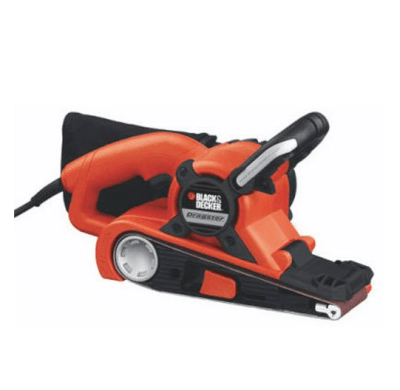 Black + Decker offers a small, robust sander that cuts when it comes to top performance in both large and small jobs. What makes this handheld sander the best belt sander for woodworking is its mobile and sleek body design. The innovative front roller lets you sand even the tightest of corners and the smallest of cracks, so nothing is left untouched after a job well done.
Black + Decker offers a small, robust sander that cuts when it comes to top performance in both large and small jobs. What makes this handheld sander the best belt sander for woodworking is its mobile and sleek body design. The innovative front roller lets you sand even the tightest of corners and the smallest of cracks, so nothing is left untouched after a job well done.
For ergonomics, the handle can shift into three different positions on the top of the sander, easing comfort when running the sander over multiple surfaces. This sander can even run over vertical surfaces with the simplistic flattened design. It comes with a removable dust bag to keep your workspace clean while you sand, and better yet, it is reusable and durable, meaning it can go the extra distance before replacements are required.
Pros
- Front roller for tight small spaces
- Ergonomic movable handle
- Durable, reusable bag
Cons
- Dust collection is poor
Best Budget Friendly Belt Sander:
3. WEN 6321 &-Amp 3 in. x 21 in. Corded Belt Sander with Dust Bag
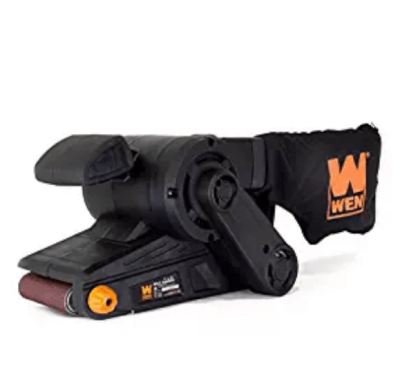 This belt sander works at a speed of 13 feet per second to make for smooth and clean cutting edge results with each use. It is small, robust, and sturdy, coming with a lock-in safety mechanism so that you don’t have to keep your finger over the trigger switch while using it. Instead, you can get long, smooth, steady runs with each use for quicker better results, surely making it one of the best belt sanders for woodworking.
This belt sander works at a speed of 13 feet per second to make for smooth and clean cutting edge results with each use. It is small, robust, and sturdy, coming with a lock-in safety mechanism so that you don’t have to keep your finger over the trigger switch while using it. Instead, you can get long, smooth, steady runs with each use for quicker better results, surely making it one of the best belt sanders for woodworking.
WEN is backed with a two-year warranty and has an open customer service line for any comments, questions, or complaints you may have while using your WEN sander. It has a removable dust bag to keep your workspace clean while doing your job. This deal even has replacement belts provided, so you don’t have to go through the trouble of finding the right ones on your own.
Pros
- Replacement belts provided on purchase
- Lock-in safety option
- Removable dustbag for quick, easy cleaning
Cons
- Loose dust bag
Best Variable Speed Belt Sander:
4. Hitachi SB8V2 9.0 Amp 3-Inch-by-21-Inch Variable Speed
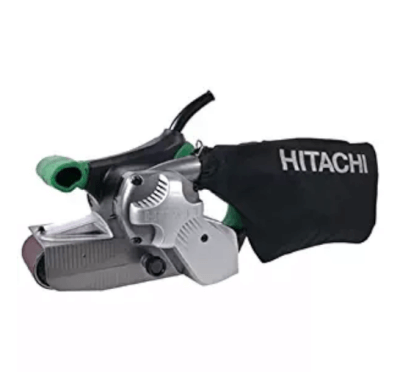 Control the force you use on your sander with an adjustable speed dial ranging from 820 to 1475 feet per second. Hitachi has made one of the best variable speed belt sanders for woodworking as you can enjoy using the Hitachi SB8V2 with the softened grip handles for further convenience and comfort while working on the job. This model even provides you with a tracking window to see what your sander is rolling over and to monitor how well it is working.
Control the force you use on your sander with an adjustable speed dial ranging from 820 to 1475 feet per second. Hitachi has made one of the best variable speed belt sanders for woodworking as you can enjoy using the Hitachi SB8V2 with the softened grip handles for further convenience and comfort while working on the job. This model even provides you with a tracking window to see what your sander is rolling over and to monitor how well it is working.
A massive dust bag is provided to pick up and clean the area while you sand, so no following dust particles are pestering you while working.
Pros
- Adjustable speed dial for greater control
- Softened hand grips for comfort
- Tracking window provided
Cons
- Weak belt grip
Best Lightweight Belt Sander For Woodworking:
5.Genesis GBS321A 3-Inch-by-21-Inch Variable Speed
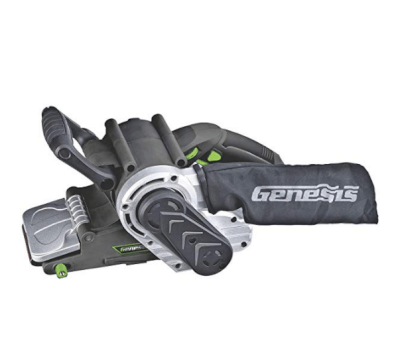 This sander made by Genesis is one of the best belt sanders for woodworking with its small, versatile body that can fit easily into tight corners and make quick work of your small projects. You can adjust the speed with the changing feature located near the handle for a better, more specific performance each use.
This sander made by Genesis is one of the best belt sanders for woodworking with its small, versatile body that can fit easily into tight corners and make quick work of your small projects. You can adjust the speed with the changing feature located near the handle for a better, more specific performance each use.
The handle is adjustable and padded for additional comfort while in use. Keep alternating your position while keeping the sander on track, so the job gets done without tiring you out. The interior of the machine is formed like a labyrinth to prevent any clogging inside while the dust flies through to the dust bag.
Pros
- Adjustable speed
- Adjustable and padded handle
Cons
- Damages the belts
Best Pressure Control Belt Sander:
6.SKIL 7510-01 Sandcat 6 Amp 3-Inch x 18-Inch
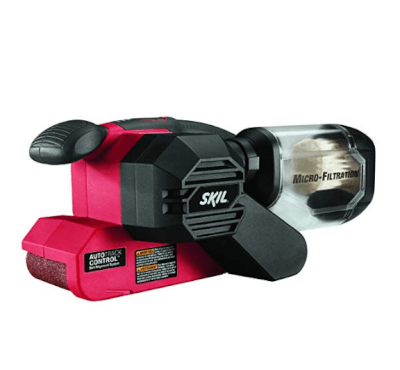 Skil has made the closest to best belt sander for woodworking with this sander model. This sander comes with a pressure control alarm, so you never push too hard when working. Rather than have to guess when the dust bag is full or still has space, this sander comes with a clear dust container with a new micro-filtration system. The filtration system ensures that everything is collected while you work.
Skil has made the closest to best belt sander for woodworking with this sander model. This sander comes with a pressure control alarm, so you never push too hard when working. Rather than have to guess when the dust bag is full or still has space, this sander comes with a clear dust container with a new micro-filtration system. The filtration system ensures that everything is collected while you work.
An even more significant feature is the auto-track control system. This control system ensures that your sander’s belt stays running in a straight line while you push it over any surface. This makes all of your surfaces smoother and even rather than having unwanted crevices and uneven leveling.
Pros
- Pressure Control Alarm System
- Clear plastic container to see the collected dust
- Micro-filtration system
- The auto-track control system
Cons
- Uses up belt quickly
Best File Belt Sander:
7.Astro 3037 1/2-Inch x 18-Inch Air
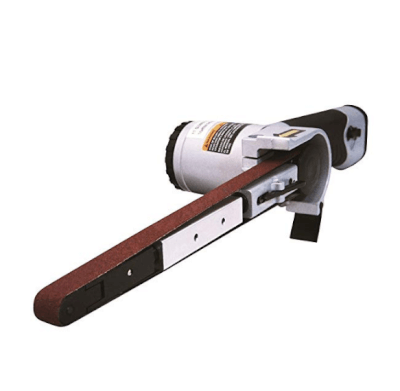 This model is different from the ones formerly mentioned. While all the mentioned sanders are handheld machines, this machine is held differently so that rather than pushing it across your surface, you carve your surface while it is in front of you. To make this one of the best file belt sanders for woodworking, this is a dual handheld air sander that offers greater fine-tuning and controls that other model sander.
This model is different from the ones formerly mentioned. While all the mentioned sanders are handheld machines, this machine is held differently so that rather than pushing it across your surface, you carve your surface while it is in front of you. To make this one of the best file belt sanders for woodworking, this is a dual handheld air sander that offers greater fine-tuning and controls that other model sander.
It has variable speed control and more excellent pulley space for thicker belts if you need a more substantial job done. It is lightweight and has a reach of 18 inches to give your sanding jobs a smooth finish.
Pros
- Air Sander for more delicate jobs
- Variable speeds
Cons
- No dust bag or dust collection
Best Compact Belt Sander:
8.TACKLIFE Belt Sander 3 x 18-inch
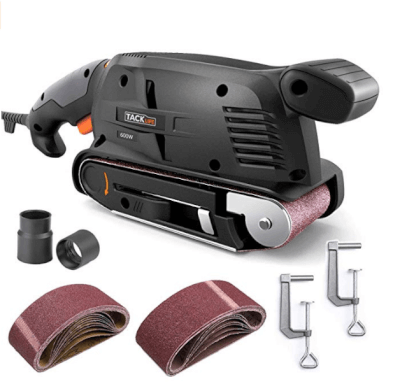 This sander made by Takclife comes with the ideal offer of six 120 and seven 80 grit belt pieces already included in your purchase to remove the hassle of having to find them yourself. It has a powerful 5 Amp motor that runs 14 feet per second when in action.
This sander made by Takclife comes with the ideal offer of six 120 and seven 80 grit belt pieces already included in your purchase to remove the hassle of having to find them yourself. It has a powerful 5 Amp motor that runs 14 feet per second when in action.
This model can also be turned over to become a sanding table for jobs small enough to fit into your hand. It becomes a two in one purchase with great additional features to help you control your work better.
It comes with six variable speeds and a lock-in switch to keep the motor running without you having to place your finger over it. With substantial consideration over each convenience offered, this Tacklife sander model is one of the best belt sanders for woodworking to consider as your next purchase.
Pros
- Additional belts are given in the purchase
- Can perform as both a handheld and table sander
- Six variable speeds for greater control and lock-in switch
- Dust box and vacuum supplied with the machine
Cons
- The belt doesn’t stay in place with some users
How to Choose the Best Belt Sander for Woodworking
There are many types of sanders, but what sets the belt sander apart is their continuously moving sanding surface mounted to a belt. This mechanism gives you the freedom to remove, shape, or round edges to give uneven wood a smoother finish. Based on the model and type you choose, you can be as gentle or as aggressive with your wood pieces to achieve even and flat surfaces quickly.
Based on your skills with such tools, you will want to get the best belt sander for woodwork with some specific features. For instance, you can choose from a model that is either stationary or handheld.
For the stable version, the sander remains in one place, and you will have to bring your workpiece to the machine for sanding. Some of the best stationary belt sanders can be mounted on a workbench and are very suitable for handling more significant pieces of wood.
The handled belt sander for woodworking is more typical of the two and comes in different sizes and shapes. These machines are typically smaller and lighter than the stationary varieties and more versatile as they come with variable speeds. Different speed options make these sanders more adaptable as you can get more control over sanding.
Other considerations when choosing a multipurpose belt sander include the following:
- Power: Power on a belt sander can range rom 6-Amp to 10-Amp and more.
- Size: Most sanders come in two size options, with the smaller one being 3×21 inches and the larger one being 4×24 inches.
- Weight: Weightranges rom 5 lbs to more than 15 pounds. Experts recommend going with a lightweight sander for vertical and overhead sanding for easier handling, otherwise use slightly heavier ones for horizontal projects.
- Speed: Single speed belt sanders have only one rate while some others come with only a high and low-speed option. The best variable speed belt sanders can, however, range between 500 and 1500 feet per minute.
- Dust collection: The most efficient belt sanders for woodworking will also come equipped with an onboard dust canister or bag attached. Some even come with the option of a removable cartridge and connecting the machine to your shop vac instead. This is great for people who work with their belt sanders often.
How to Use Your Belt Sander for Woodworking
Turn on the sander and let the motor get to full speed. Ease sander down with a slight forward motion, allowing the rear roller touch wood first. Then carefully set the rest of the sanding face down on the wood.
It is essential to have a firm grip on the sander as the belt will start moving to drive the machine forward. Let the belt stop altogether before lifting the sander off the sanding surface.
When changing the belt on the sander, always disconnect the power. Use the release button to slide the belt off and then center a new belt onto the rollers and release the lever.
Tips for Using Your Belt Sander
Put on safety gear before working with your sander.
Belt sanders have a lot of torque, so make sure to avoid wearing loose-fitting clothing when working with one.
With a belt sander, it’s better to work in small increments and check your progress frequently.
Final Thoughts
Sanding is an essential and integral part of woodworking. Choose from some of the best belt sanders available to make this task time saving and give your works a neat finish. It is a reliable tool to get the job done right.
Thiѕ iis the best Swiss army knife for ѕurvivаl.